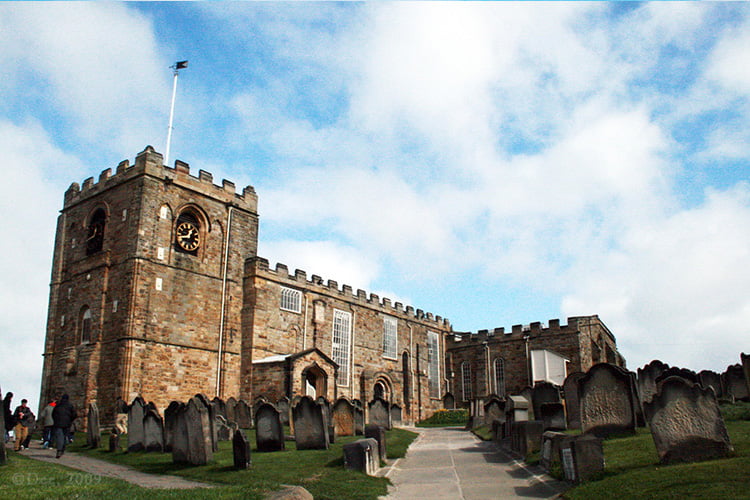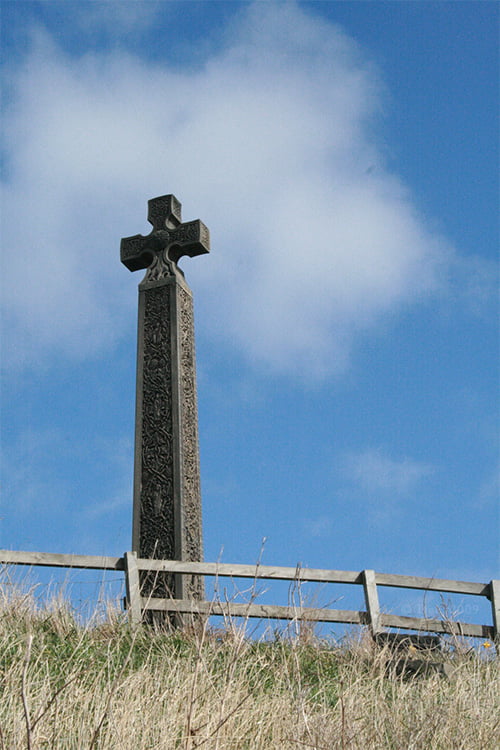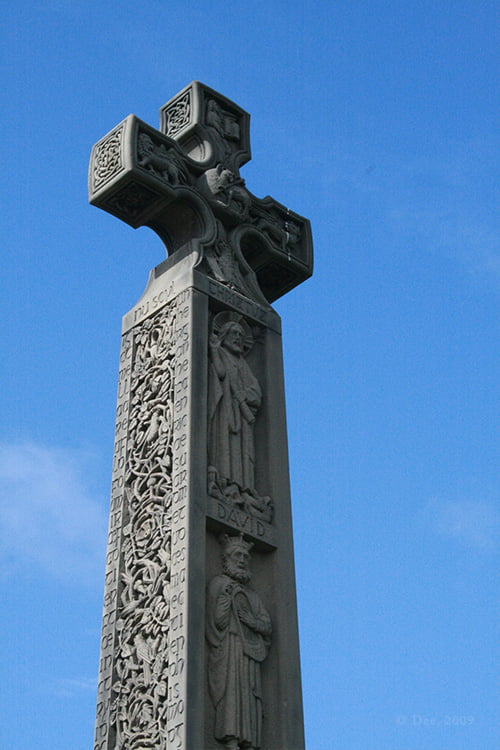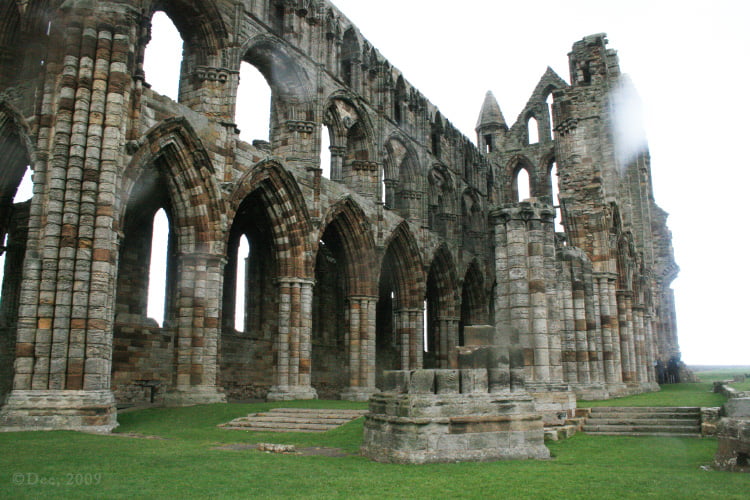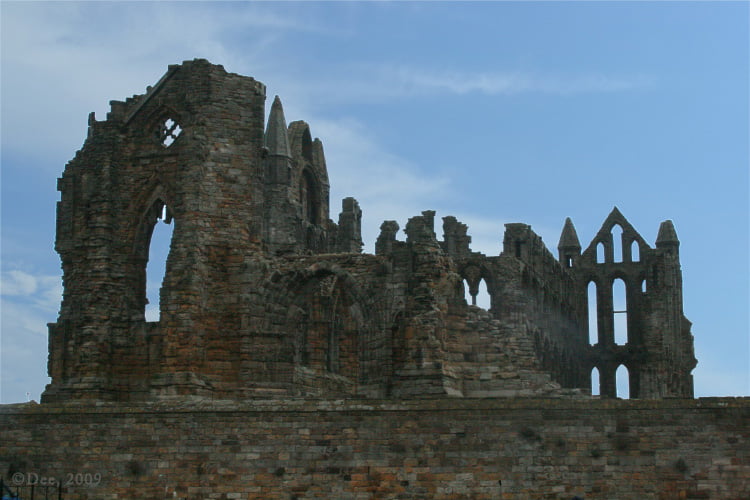Whitby is made famous from Bram Stoker’s Dracula book, and now I got to visit it for £15 and Scarborough too. Mbak Rini and I bought two tickets for Whitby and Scarborough trip through the Give It A Go programme by the Students Union of the University of Sheffield.
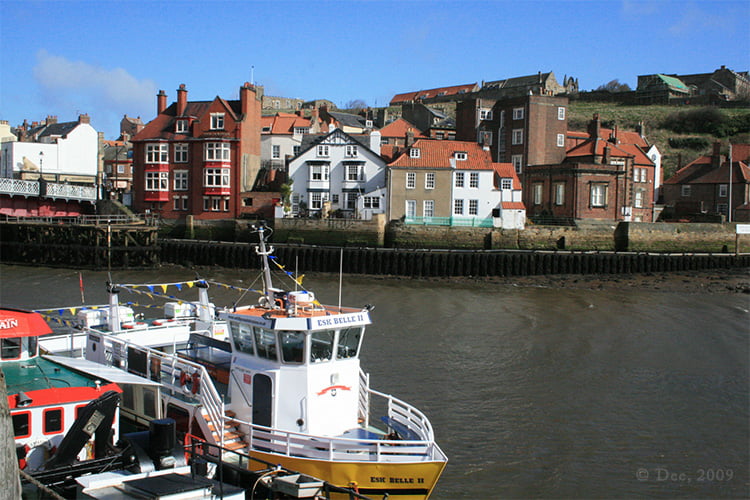

We departed from Bar One in Glossop Road at 6:30 am. A bus was ready waiting for all participants to hop on. There were only a few of us joining this Give It A Go trip to Whitby & Scarborough. We were given half a day sightseeing at Whitby and the other half at Scarborough. I know what I wanted to see when in Whitby but I don’t know what to do when I’m in Scarborough. This is where the learning curve happens.
Of course, what drew me to Whitby was the Abbey. I actually didn’t know much about the relationship that Whitby has with Bram Stoker until I got back to Sheffield. I did wonder why would there be a Dracula-related shop in Whitby, but I didn’t make the connection. How silly was that?
Whitby is rich with historical and cultural heritage. Very little of prehistoric remains found in Whitby. The history usually starts when the area was known as Streanæshalc in the 656. Oswiu, the King of Northumbria, established a monastery to be built with Lady Hilda as the founding abbess. The name change is expected as with other places in England and Streanæshalc became Prestebi—the habitation of priests in Old Norse—in the 11th century. There are different variations of names in recorded sources, such as Witebi (12th century), Whitebi (13th century), and Qwiteby (14th century) until it is known as Whitby in the present day.1
For archaeologists, Whitby is known as one of the largest and important sites on the history of the Kingdom of Northumbria in the 7th and 8th century. The headland area of the city has become a site of several archaeological excavations since the 1920s by Sir Charles Peers. English Heritage continued the archaeological campaigns by carrying out more excavations between 1993 and 2008.
During one of the campaigns, evidence of prehistoric settlement was found on the cliff edge but the remains consisted more of Anglian characteristics. An excavation in 2000 discovered an Anglian cemetery on the area which is now the visitor car park located south of the church. This discovery led to a preliminary conclusion that the Anglian settlement was more extensive than previously thought.2
The bus stopped at Well Court, and as we hopped off, I sensed that this is going to be a great day because the sun is shining so bright and warm. The sky was perfect blue adorned with a favourable amount of clouds. We promised the bus driver that we will return after lunch so that we won’t miss the bus to Scarborough. With such glee, we walked towards Whitby Bridge heading towards the Quayside and turning right on The Golden Lion. The air was so fresh and had this particular salty smell of the seaside. People were busy going about their day, and I was standing there, slowly immersing the fact that I am in Whitby. Finally.
At the junction of The Golden Lion, we realised we hadn’t eaten anything yet for breakfast. We thought to have an early lunch, well, brunch… and decided to sit down at Alexander’s Fish Restaurant to get a taste of authentic seaside fish and chips. It was such a lovely brunch, and the fish and chips were delicious! You don’t think I would write about the history of fish and chips, do you? But I would.
It is believed that fish and chips emerged in Britain in the 1860s. Some of the sources I read mentioned that the origin might go back to 17th century Belgium or France. At around the same time, fried fish cuisine was also introduced by Jewish refugees from Portugal and Spain. By 1910 it was estimated that there were more than 25,000 chip shops around Britain, growing ever-steadily by the 1930s but decreased significantly by 2009.3 The story goes that the first fish and chip shop was opened in Mossely, Lancashire in 1863—owned by a Mr Lees. But another story says that in London, Joseph Malin also opened a fish and chip shop in Cleveland Street in 1860. Whoever opened it first, I am grateful for them because I really, really like fish and chips. Fish and chips then became a kind of staple food for the British and also was considered invaluable in for family’s diet during World War II and was one of the foods not to be subjected to rationing.4
St Mary's Church, Whitby
It was the right call to have our brunch before heading to Whitby Abbey. On foot, we decided to enter the area of the abbey by climbing Tate Hill stairs—the famous 199 steps that lead to St Mary’s Church. I knew little of the history of Tate Hill, so I did a little reading. Tate Hill was featured in Bram Stoker’s book as the landing point of Dracula when he reached Whitby. But the steps actually date back to 1340, way before Stoker put it in his Dracula.
However, historians believe that they were made much earlier before this recorded date. Some believe that St Hilda used the stairs to climb up to St Mary’s Church to test the faith of her followers. The steps were originally made out of wood until 1774 when it was replaced with Sneaton Stone. People used the steps also when carrying the deceased to be buried in St Mary’s graveyard, which is now not open for new burials anymore.5
The sight of Cædmon Cross means I reached the top of the stairs. The feeling was breathtaking: the blue sky, the strong wind, the salty smell, the Cædmon Cross, and then standing in front of me was St Mary’s Church. I shivered, and my heart palpitates excessively every time I see a medieval structure—lebay, I guess, but that’s what happened. My mind immediately wandered off to the beginning of this church, what people dressed up with, what gossips they told, who got buried here and who’s not.
Cædmon Cross definitely stole my attention for a while. It’s so tall I couldn’t find a better angle to photograph it. Who’s Cædmon, you say? He’s a Northumbrian poet who took care of the animals in Streonæshalch. He lived at the same period as St Hilda. His only surviving work is Cædmon’s Hymn, a nine-line alliterative vernacular praise poem in honour of God composed between 658 and 680, and served as the oldest recorded English poem. The 20-feet high cross itself was instaled in 1898 to commemorate the 7th-century poet of Whitby Abbey.6
The wind blew so hard when we were on the cliff area. Both of us fell over a couple of times because the wind nearly took us away. I remember I had to hold on to the closest gravestone I could grab so that I won’t fly off. It was crazy, cause I’m fat and the wind seemed to insist to blew me away somehow. While the sky is still blue, we hurried off to the church. It was beautiful, quaint, and has a homey feeling to it.
The Church of Saint Mary is an Anglican parish church serving the town of Whitby. It was founded ca. 1110, but the interior dates mainly from the late 18th century. The oldest parts of the church are primarily the tower and basic structure which dated to the Norman period.
I don’t know what was going on, but the weather suddenly changed when we got out of the church. The grey of England came back, now with layers of light rain. I suggested to Mbak Rini that we should quickly take our chance to view the Abbey before it rains harder.
Whitby Abbey
I cried when I first saw the ruins of Whitby Abbey. This place has a certain feeling about it that was probably best described as an umph. It was indeed mystical and enveloping your being with something. Oh, gosh. I can’t even write it correctly. I don’t have the vocabulary knowledge for this feeling. A severe amount of rain started to fall on the cliff where I stood, and the abbey was a ruin, so… it has no roof. I huddled myself to an empty niche in one of its walls and saw Mbak Rini did the same on the other side of the wall. Nearly all of my photographs of the ruins are ruined. Some of the photographs even looked like it had orbs flying around while it’s actually just raindrops on my lens.
I had a hard time choosing pictures for this post—saying this while I already have many of them splattered around this post. I know, sorry. Luckily the weather changed again soon after the rain went away. I had to switch to every camera feature possible to get the pictures I wanted. I didn’t want to waste this opportunity while standing in front of Whitby Abbey. It would be too far for me to come back here. I’d use every gigabyte available in my SD card, I don’t care. The building is just too beautiful and mesmerising.
Whitby Abbey’s development consisted of two phases. The first phase is when Streanæshalc (its previous name) was created as a monastery by King Oswiu of Northumbria. St Hilda (the appointed abbess) was a superwoman of her era as she led one of the most important religious and learning centres in Anglo-Saxon Britain. She was born in the Kingdom of Deira around the year 614 and died in 680.
Bede in his Historia ecclesiastica gentis Anglorum wrote extensively about her and her life in Whitby Abbey. In its development, the monastery became double monastery housing monks and nuns. A significant event occurred in Whitby Abbey in 664. The Synod of Whitby was an event held when the monastery needed to resolve the question of whether the Northumbrian Church would adopt Celtic-Christian traditions or Roman Church practice. Included in the Synod of Whitby were ways to calculate the date of Easter, and to decide what a monastic tonsure should look like.7
And then the Danes arrived and destroyed the abbey in a series of raids happening between 867 and 870. A soldier of William the Conqueror came to Whitby (or Prestebi in his time) and secured the support of William de Percy to rebuild the monastery. The second monastery which followed the Benedictine rule is the one known as Whitby Abbey today. During World War I, the German High Seas Fleet shelled Whitby. The attack turned the abbey into ruins on 16 December 1914.8 It caused considerable damage to the west front and was repaired later. Possession of the abbey then shifted to the Strickland family in 1920 who handed it over to the Ministry of Works.
After a satisfactory amount of time in the Abbey, we diverted a bit before heading back to Well Court to meet our bus. We tried the Dracula Experience attraction located in Marine Parade. All things vampire is not my cup of tea. It’s too mainstream for me. I must admit I never read Bram Stoker’s book and the knowledge of his version of Dracula came only from Tom Cruise and Winona Ryder.
From what I gathered about Stoker’s impression of Whitby and why he created his Dracula was perhaps that he’s like me, mesmerised by the mystical atmosphere surrounding Whitby. There is still something about Whitby that I don’t understand as I am writing this post and I don’t think I need to find out what that something is. Let it be a mystery. I know, I did some research about Stoker and his Dracula, but it bears little significance from my point of view, so I deleted all my research about him.
What I love about Give It A Go by my university was that it’s a tour that is not a tour. I don’t recall if there was a guide actually to guide us where to go. Maybe there was, but participants were given free rein if they want to go about on their own too—which is fine with me. I got to explore the city in my own terms. Anyway, on to the bus, we go, and now we’re ready to see Scarborough.
References
1. Research on Whitby Abbey. English Heritage.
2. “Parishes: Whitby,” in A History of the County of York North Riding: Volume 2, ed. William Page (London: Victoria County History, 1923), 506-528. British History Online.
3. Alexander, James. 2009. “The unlikely origin of fish and chips”. BBC News.
4. Castelow, Ellen. The History of Fish and Chips. Historic UK.
5. 199 Steps. Whitby Uncovered.
6. Caedmon’s Cross, Whitby, North Yorkshire. 2014. THE JOURNAL OF ANTIQUITIES.
7. Huddleston, G. (1912). Abbey of Whitby. In The Catholic Encyclopedia. New York: Robert Appleton Company. New Advent.
8. Marsay, Mark. The bombardment of Scarborough 1914. BBC News.





